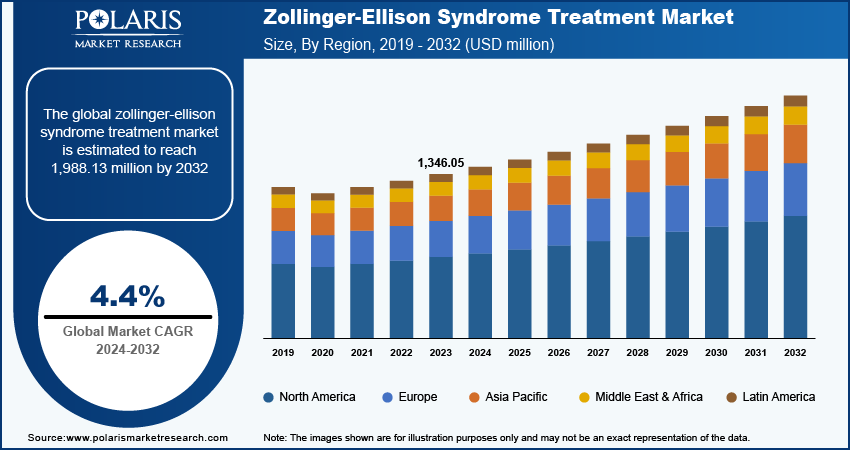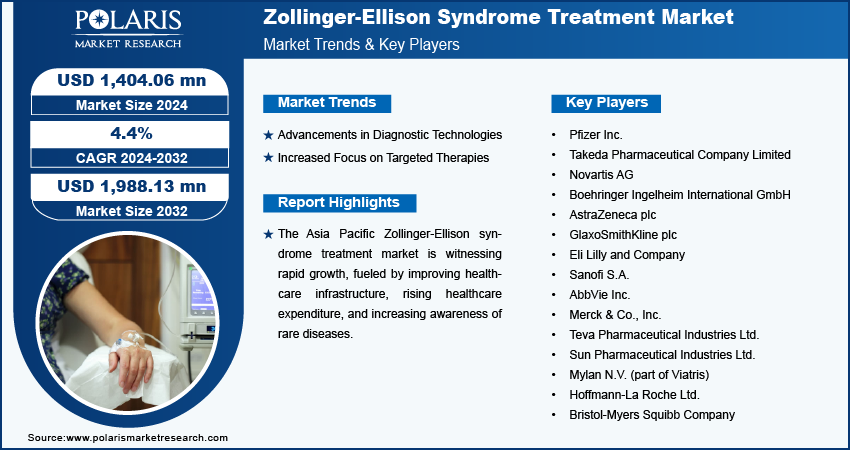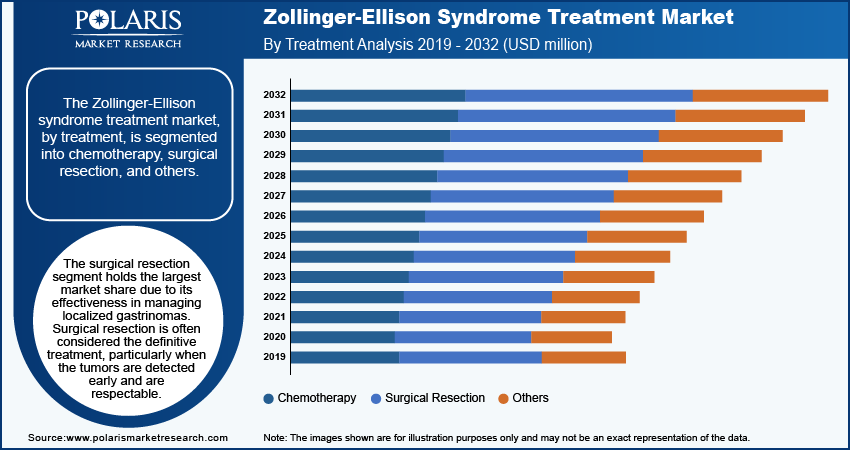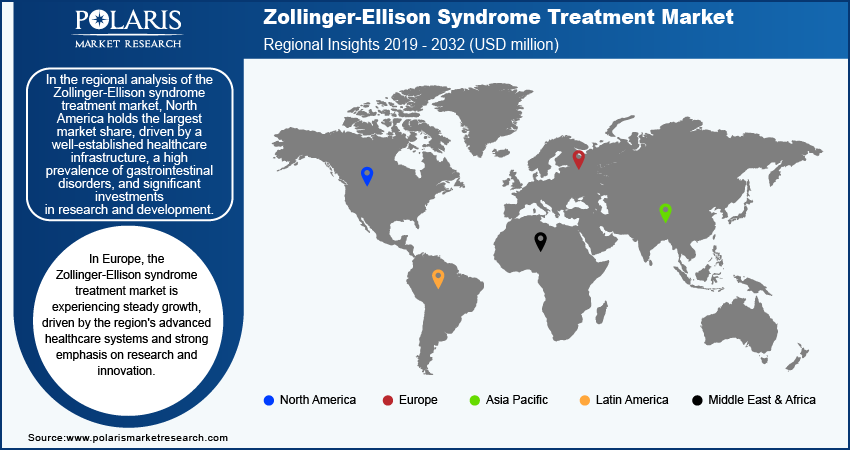
Zollinger-Ellison Syndrome Treatment Market Size, Share, Trends, Industry Analysis Report
: By Treatment (Chemotherapy, Surgical Resection, and Others); Diagnosis; End Users; and Region (North America, Europe, Asia Pacific, Latin America, and Middle East & Africa) – Market Forecast, 2024–2032
- Published Date:Oct-2024
- Pages: 118
- Format: PDF
- Report ID: PM5080
- Base Year: 2023
- Historical Data: 2019-2022
Zollinger-Ellison Syndrome Treatment Market Overview
The global Zollinger-Ellison syndrome treatment market size was valued at USD 1,346.05 million in 2023. The market is projected to grow from USD 1,404.06 million in 2024 to USD 1,988.13 million by 2032, exhibiting a CAGR of 4.4% during 2024–2032.
The global Zollinger-Ellison syndrome (ZES) treatment market encompasses various medical therapies and interventions aimed at managing this rare disorder, characterized by tumors known as gastrinomas that cause excessive gastrin production. This leads to severe peptic ulcers and gastric acid hypersecretion.
Market growth is driven by several factors, including the increasing prevalence of gastrointestinal disorders, advancements in diagnostic techniques, and heightened awareness of rare diseases. Additionally, trends such as the development of novel therapeutic agents, the rise of personalized medicine, and increased research and development activities are expected to further propel market growth during the forecast period. The market is also influenced by the growing demand for minimally invasive surgeries and the availability of improved healthcare infrastructure in developed regions.

To Understand More About this Research: Request a Free Sample Report
Zollinger-Ellison Syndrome Treatment Market Drivers and Trends
Advancements in Diagnostic Technologies
Early and accurate diagnosis is critical for managing ZES, as delayed treatment can lead to severe complications. Innovations such as improved imaging techniques, including endoscopic ultrasound (EUS) and somatostatin receptor scintigraphy (SRS), have significantly enhanced the ability to detect gastrinomas at earlier stages. Furthermore, the development of more sensitive assays for measuring gastrin levels in the blood has improved diagnostic accuracy, allowing for better treatment planning. According to a study published in Gastroenterology in 2022, the sensitivity of new diagnostic tests has increased by ∼15% over the past decade. Therefore, the rapid advancement in diagnostic technologies for ZES treatment fuels the Zollinger-Ellison syndrome treatment market growth.
Increased Focus on Targeted Therapies
Healthcare experts and patients are preferring targeted therapies for managing chronic diseases. Traditional ZES treatments such as proton pump inhibitors (PPIs) and H2-receptor antagonists are complemented. In some cases, traditional treatments are replaced by targeted therapies as they aim to address the root cause of the syndrome, such as controlling gastrin-producing tumors. Advances in molecular biology and genomics have enabled the development of drugs that specifically target the receptors or pathways involved in tumor growth and gastrin secretion. The introduction of personalized medicine has led to more effective and tailored treatments, improving patient outcomes and reducing side effects. Therefore, the rising focus on targeted therapies would drive the growth of the Zollinger-Ellison syndrome treatment market in the coming years.
Growing Emphasis on Minimally Invasive Surgeries
Surgical intervention remains a crucial option for managing gastrinomas. Minimally invasive techniques, such as laparoscopic and robotic-assisted surgeries, offer several advantages over traditional open surgeries, including reduced recovery times, lower complication risks, and shorter hospital stays. Data from the Journal of the American College of Surgeons in 2023 indicates that minimally invasive surgeries for gastrinoma removal have increased by 25% over the past five years, reflecting their growing acceptance in clinical practice. This trend is expected to continue in the Zollinger-Ellison syndrome treatment market during 2024–2032 as minimally invasive surgical technologies and techniques further evolve.

Zollinger-Ellison Syndrome Treatment Market – Segment Insights
Zollinger-Ellison Syndrome Treatment Market Breakdown – Treatment-Based Insights
The Zollinger-Ellison syndrome treatment market, by treatment, is segmented into chemotherapy, surgical resection, and others. The surgical resection segment holds the largest market share due to its effectiveness in managing localized gastrinomas. Surgical resection is often considered the definitive treatment, particularly when the tumors are detected early and are resectable. The procedure alleviates symptoms by removing the source of excessive gastrin production and offers a potential cure, making it the preferred option for eligible patients. As advancements in minimally invasive surgical techniques continue, the demand for surgical resection is expected to remain strong in the coming years, driven by its high success rate and improved patient outcomes.
The chemotherapy segment is registering the highest growth rate in the market. This segment is particularly crucial for managing metastatic or inoperable tumors, where surgical options are limited. The introduction of novel chemotherapeutic agents and combination therapies has significantly enhanced the effectiveness of chemotherapy in controlling tumor growth and prolonging patient survival. Additionally, ongoing research into new drug formulations and targeted chemotherapy options drives the growth of this segment, as it addresses the unmet needs of patients suffering from advanced Zollinger-Ellison syndrome.
Zollinger-Ellison Syndrome Treatment Market – End Users-Based Insights
In terms of end users, the Zollinger-Ellison syndrome treatment market is segmented into hospitals, specialty clinics, and others. The hospitals segment holds the largest market share, primarily due to the comprehensive care they offer, including advanced diagnostic facilities, access to multidisciplinary teams, and the ability to perform complex surgical procedures. Hospitals are equipped with the necessary infrastructure to manage routine and critical cases of Zollinger-Ellison syndrome, making them the preferred choice for most patients. Additionally, hospitals are often at the forefront of adopting new technologies and treatment protocols, further solidifying their dominant position in the market.
The specialty clinics segment is registering the highest growth rate within this market. Specialty clinics, which focus on treating gastrointestinal disorders and rare diseases, are increasingly sought after for their specialized expertise and personalized care. These clinics often provide targeted treatments, including access to the latest drug therapies and minimally invasive procedures, which are particularly important for managing a rare and complex condition such as Zollinger-Ellison syndrome. The growing trend toward outpatient care, along with the rising patient preference for focused and specialized treatment settings, is driving the rapid expansion of this segment.

Zollinger-Ellison Syndrome Treatment Market – Regional Insights
By region, the study provides market insights into North America, Europe, Asia Pacific, Latin America, and the Middle East & Africa. In the regional analysis of the Zollinger-Ellison syndrome treatment market, North America holds the largest market share, driven by a well-established healthcare infrastructure, a high prevalence of gastrointestinal disorders, and significant investments in research and development. The presence of leading pharmaceutical companies and specialized healthcare providers in the US and Canada also contributes to the region's dominance. Additionally, the availability of advanced diagnostic tools and treatment options, coupled with strong awareness and early diagnosis of rare diseases, enhances North America's leading position in the market. Europe and Asia Pacific follow North America, with growing healthcare investments and increasing awareness driving market growth in these regions.
In Europe, the Zollinger-Ellison syndrome treatment market is experiencing steady growth, driven by the region's advanced healthcare systems and strong emphasis on research and innovation. Countries such as Germany, France, and the UK are leading contributors to the market due to their robust healthcare infrastructure and high investments in rare disease treatment. The European market benefits from supportive government policies and funding initiatives that encourage the development and adoption of novel therapies. Additionally, the presence of specialized centers and expert clinicians in the region ensures access to high-quality care for patients affected by Zollinger-Ellison syndrome. Increasing awareness and early diagnosis efforts are also contributing to the market's expansion in Europe.
The Asia Pacific Zollinger-Ellison syndrome treatment market is witnessing rapid growth, fueled by improving healthcare infrastructure, rising healthcare expenditure, and increasing awareness of rare diseases. Countries such as China, Japan, and India are at the forefront of this growth, with significant investments in healthcare modernization and expanding access to advanced medical treatments. The region is also witnessing a rise in the adoption of innovative diagnostic technologies and treatment options, particularly in urban areas with better healthcare facilities. Additionally, the growing prevalence of gastrointestinal disorders and the increasing focus on early diagnosis and intervention are making it a key emerging market.

Zollinger-Ellison Syndrome Treatment Market – Key Players and Competitive Insights
The Zollinger-Ellison syndrome treatment market includes several key players that are actively involved in developing and providing treatments for this rare condition. Pfizer Inc.; Takeda Pharmaceutical Company Limited; Novartis AG; Boehringer Ingelheim International GmbH; AstraZeneca plc; GlaxoSmithKline plc; Eli Lilly and Company; Sanofi S.A.; AbbVie Inc.; and Merck & Co., Inc. are among the prominent companies. Additionally, companies such as Teva Pharmaceutical Industries Ltd., Sun Pharmaceutical Industries Ltd., Mylan N.V. (now part of Viatris), Hoffmann-La Roche Ltd., and Bristol-Myers Squibb Company are significant players in this market, contributing to the availability of various treatment options.
Competitive analysis reveals that these companies are highly focused on research and development to introduce new and more effective therapies for ZES. The market is characterized by a mix of large pharmaceutical companies with extensive R&D capabilities and a strong global presence, along with smaller firms specializing in niche therapies for rare diseases. For example, Pfizer and Novartis continue to invest in innovative treatments and have a broad portfolio that includes drugs for managing gastric acid hypersecretion, which is critical for Zollinger-Ellison syndrome. Meanwhile, companies such as Takeda and AstraZeneca are leveraging their expertise in gastrointestinal treatments to strengthen their position in the market.
In terms of competitive insights, the market is highly dynamic, with significant collaboration and strategic partnerships among key players to enhance their product offerings. For instance, some companies are exploring combination therapies or personalized treatment options to improve patient outcomes, while others focus on expanding their geographic reach, particularly in emerging markets such as Asia Pacific. The competitive landscape also shows that mergers and acquisitions are common, as larger companies acquire specialized firms to broaden their rare disease portfolios. However, competition remains intense, with continuous efforts to innovate and address the unmet needs of ZES patients.
Pfizer Inc. is a significant player in the Zollinger-Ellison syndrome treatment market, with a broad portfolio of medications that address gastrointestinal conditions. The company is known for its commitment to developing innovative therapies and has a strong presence in established and emerging markets. Pfizer continues to invest in research and development to enhance its offerings in the treatment of rare diseases, including Zollinger-Ellison syndrome.
Novartis AG is another key player in this market, recognized for its extensive range of pharmaceutical products targeting various health conditions, including those related to gastric acid hypersecretion. The company has a history of innovation in drug development and remains actively involved in research to address the needs of patients affected by Zollinger-Ellison syndrome.
Key Companies in Zollinger-Ellison Syndrome Treatment Market
- Pfizer Inc.
- Takeda Pharmaceutical Company Limited
- Novartis AG
- Boehringer Ingelheim International GmbH
- AstraZeneca plc
- GlaxoSmithKline plc
- Eli Lilly and Company
- Sanofi S.A.
- AbbVie Inc.
- Merck & Co., Inc.
- Teva Pharmaceutical Industries Ltd.
- Sun Pharmaceutical Industries Ltd.
- Mylan N.V. (part of Viatris)
- Hoffmann-La Roche Ltd.
- Bristol-Myers Squibb Company
Zollinger-Ellison Syndrome Treatment Industry Developments
- In July 2023, Novartis announced its decision to launch a new clinical trial aimed at evaluating a novel therapy for managing rare gastrointestinal disorders, underscoring its dedication to advancing treatment options in this area.
- In April 2023, Pfizer announced its collaboration with a BioNTech firm to explore new treatment modalities for gastrointestinal disorders, signaling its ongoing focus on advancing care for conditions such as Zollinger-Ellison syndrome.
Zollinger-Ellison Syndrome Treatment Market Segmentation
By Treatment Outlook
- Chemotherapy
- Surgical Resection
- Others
By Diagnosis Outlook
- Blood Test
- CT scan Ultrasound
- X-Ray
- Others
By End Users Outlook
- Hospitals
- Specialty Clinics
- Others
By Regional Outlook
- North America
- US
- Canada
- Europe
- Germany
- France
- UK
- Italy
- Spain
- Netherlands
- Russia
- Rest of Europe
- Asia Pacific
- China
- Japan
- India
- Malaysia
- South Korea
- Indonesia
- Australia
- Vietnam
- Rest of Asia Pacific
- Middle East & Africa
- Saudi Arabia
- UAE
- Israel
- South Africa
- Rest of Middle East & Africa
- Latin America
- Mexico
- Brazil
- Argentina
- Rest of Latin America
Zollinger-Ellison Syndrome Treatment Market Report Scope
|
Report Attributes |
Details |
|
Market Size Value in 2023 |
USD 1,346.05 million |
|
Market Size Value in 2024 |
USD 1,404.06 million |
|
Revenue Forecast by 2032 |
USD 1,988.13 million |
|
CAGR |
4.4% from 2024 to 2032 |
|
Base Year |
2023 |
|
Historical Data |
2019–2022 |
|
Forecast Period |
2024–2032 |
|
Quantitative Units |
Revenue in USD million and CAGR from 2024 to 2032 |
|
Report Coverage |
Revenue Forecast, Market Competitive Landscape, Growth Factors, and Trends |
|
Segments Covered |
|
|
Regional Scope |
|
|
Competitive Landscape |
|
|
Report Format |
|
|
Customization |
Report customization as per your requirements with respect to countries, regions, and segmentation. |
FAQ's
The global Zollinger-Ellison syndrome treatment market size was valued at USD 1,346.05 million in 2023 and is projected to grow to USD 1,988.13 million by 2032.
The global market is projected to register a CAGR of 4.4% during 2024–2032.
North America accounted for the largest share of the global market in 2023.
Pfizer Inc.; Takeda Pharmaceutical Company Limited; Novartis AG; Boehringer Ingelheim International GmbH; AstraZeneca plc; GlaxoSmithKline plc; Eli Lilly and Company; Sanofi S.A.; AbbVie Inc.; and Merck & Co., Inc. are among the key market players.
The surgical resection segment accounted for the largest share of the global market in 2023.
The hospitals segment accounted for the largest market share.
Zollinger-Ellison Syndrome (ZES) treatment primarily focuses on managing excessive gastric acid production and addressing the underlying gastrin-secreting tumors, known as gastrinomas. The mainstay of treatment includes the use of proton pump inhibitors (PPIs) or H2-receptor antagonists to control acid secretion and alleviate symptoms such as severe peptic ulcers. Surgical resection is often considered for patients having localized tumors that can be surgically removed. For those affected by metastatic or inoperable tumors, chemotherapy or targeted therapies may be employed to manage tumor growth.
A few key trends in the Zollinger-Ellison syndrome treatment market are described below: Increased Focus on Targeted Therapies: Development and use of therapies that specifically target gastrin-secreting tumors and related pathways. Advancements in Diagnostic Technologies: Adoption of advanced imaging techniques and sensitive assays to enhance early diagnosis and treatment planning. Growing Emphasis on Minimally Invasive Surgeries: Increased use of laparoscopic and robotic-assisted surgeries for tumor removal, offering benefits such as reduced recovery times and lower risk of complications. Rising Investments in Research and Development: Ongoing research into novel drugs and treatment modalities to improve patient outcomes and address unmet needs.
A new company entering the Zollinger-Ellison syndrome treatment market must focus on developing innovative therapies that address the specific needs of patients, such as targeted treatments for gastrin-secreting tumors and personalized medicine approaches. Emphasizing advancements in diagnostic technologies to enable early and accurate detection can also differentiate the company from competitors. Building partnerships with research institutions and healthcare providers could foster collaborative innovation and enhance treatment options. Additionally, exploring opportunities in emerging markets where healthcare infrastructure is expanding can offer new growth avenues
Companies offering Zollinger-Ellison syndrome treatment solutions and diagnostic tests, healthcare providers, and other consulting firms must buy the report.
